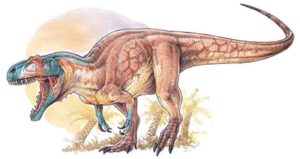
A new find from Patagonia sheds light on the evolution of large predatory dinosaurs. Features of the 8-meter-long specimen from the Middle Jurassic suggest that it records a phase of rapid diversification and evolutionary experimentation.
In life, it must have been an intimidating sight. The dimensions of the newly discovered dinosaur fossil suggest that this individual was up to 8 meters long, and its skull alone measured 80 centimeters from front to back. The specimen was uncovered by the Munich paleontologist Oliver Rauhut in Patagonia, and can be assigned to the tetanurans—the most prominent group of bipedal dinosaurs, which includes such iconic representatives as Allosaurus, Tyrannosaurus and Velociraptor. This is also the group from which modern birds are derived. The new find is the most complete dinosaur skeleton yet discovered from the early phase of the Middle Jurassic, and is between 174 and 168 million years old. The specimen represents a previously unknown genus, and Rauhut and his Argentinian colleague Diego Pol have named it Asfaltovenator vialidadi. The genus name includes both Greek and Latin components (including the Latin term for hunter), while also referring to the nature of the deposits in which the fossil was found and the species name honours the road maintance of Chubut, who helped in the recovery of the specimen.
Almost the entire skull is preserved, together with the complete vertebral column including parts of the pelvis, all the bones of both anterior extremities and parts of the legs. “The fossil displays a very unusual combination of skeletal characters, which is difficult to reconcile with the currently accepted picture of the relationships between the three large groups that comprise the tetanurans—Megalosauria, Allosauria and Coelurosauria,” says Rauhut, who is Professor of Palaeontology in the Department of Earth and Environmental Sciences at LMU and Senior Curator of the Bavarian State Collection for Paleontology and Geology. He and his co-author Diego Pol, who is based in the Museo Paleontológico Egidio Feruglio in Trelew (Argentina), describe the find in a paper that appears in the online journal Scientific Reports. According to the authors, A. vialidadi exhibits a diverse set of skeletal traits, which combines characters that have so far been found to be specific for various other species of dinosaurs.
The unusual mixture of morphological features displayed by A. vialidadi prompted the authors to carry out a comparative analysis with other tetanurans. They noted that around the period to which the new find can be assigned, the geographical range of this group was rapidly expanding, while the different species developed very similar sets of skeletal features.
Rauhut links the explosive evolution of the group with an episode of mass extinction that had occurred in the late stage of the Lower Jurassic, about 180 million years ago. The two researchers therefore interpret the parallel development of similar external traits in different species as an example of evolutionary experimentation during the subsequent rapid expansion and diversification of the tetanurans. The prior extinction of potential competitors will have opened up new ecological niches for the groups that survived, and the tetanurans were apparently among those that benefited.
“This is a pattern that we also observe in many other groups of animals in the aftermath of mass extinctions. It holds, for example, for the expansion and diversification of both mammals and birds following the extinction of the dinosaurs at the end of the Cretaceous 66 million years ago,” says Rauhut. It could also explain why it is so difficult to unravel the phylogenetic relationships close to the origin of many highly diversified animal groups.
Reference:
Oliver W. M. Rauhut et al. Probable basal allosauroid from the early Middle Jurassic Cañadón Asfalto Formation of Argentina highlights phylogenetic uncertainty in tetanuran theropod dinosaurs, Scientific Reports (2019). DOI: 10.1038/s41598-019-53672-7
Note: The above post is reprinted from materials provided by Ludwig Maximilian University of Munich.










